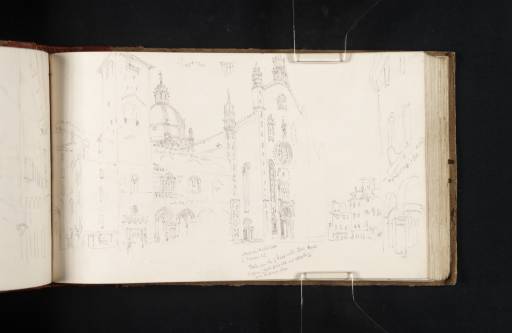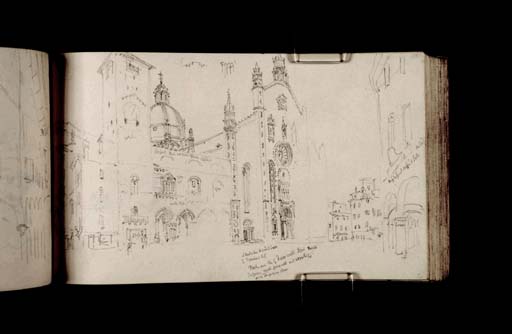Joseph Mallord William Turner The Duomo and the Broletto, Como 1819
Image 1 of 2
Joseph Mallord William Turner,
The Duomo and the Broletto, Como
1819
Joseph Mallord William Turner 1775–1851
Folio 63 Verso:
The Duomo and the Broletto, Como 1819
D14265
Turner Bequest CLXXIV 62 a
Turner Bequest CLXXIV 62 a
Pencil on white wove paper, 111 x 186 mm
Inscribed by the artist in pencil ‘white’, ‘striped Red [?corbels] Blue [...]’, ‘grey | W’, ‘grey’, ‘white Red’, and ‘striped’ within façade of Duomo. Also, and ‘Sculptured Head W door | 2 twisted col | Niches over the S door with Scul Head | Figures with [?p...] and [?or....] | and [...] [...]’ bottom centre, and ‘R[...] | [?...] caffe di Sole’ centre right-hand edge
Accepted by the nation as part of the Turner Bequest 1856
Exhibition history
1974
Turner 1775–1851, Royal Academy, London, November 1974–March 1975 (207, as ?The Duomo, Como).
References
1909
A.J. Finberg, A Complete Inventory of the Drawings of the Turner Bequest, London 1909, vol.I, p.509, as ‘A church (?Cathedral, Como); also various architectural details’.
1930
A.J. Finberg, In Venice with Turner, London 1930, pp.16, 19, 163.
1974
Gerald Wilkinson, The Sketches of Turner, R.A. 1802–20: Genius of the Romantic, London 1974, reproduced p.181 top.
1977
Gerald Wilkinson, Turner Sketches 1789–1820, London 1977, reproduced p.154 top.
2007
Federico Crimi, ‘J.M.W. Turner e il Verbano: 1819: Torino, Milano e il Sempione’, in Verbanus, no.28, 2007, p.28 note 32.
Turner’s tour of the Italian lakes began with a stay in Como where he made a number of sketches of the old port and the town from the lake. Here, however, he has made a detailed study of two of the most important buildings in the city, the Duomo (cathedral) of Como and the Broletto (city hall). The artist’s viewpoint is the north-west corner of the Piazza del Duomo and the composition presents the Duomo in the centre, with the Broletto and the civic tower adjoining it on the left. Finberg described it as a ‘marvel of rapid note-taking’ and admired Turner’s skill in crowding in the level of detail and complex perspective onto such a small page.1
Also known as the Cattedrale de Santa Maria Assunta, the Duomo stands near the lakeside in Como. Construction of the cathedral lasted between 1396 and 1770, the final element being the dome and cupola designed by Filippo Juvarra (1687–1735), and Turner’s sketch depicts the western façade which dates from 1457–98. It is notable for its Gothic design featuring a rose window, sculptures within ornate niches, and an elaborately decorated portal entrance flanked by statues of Pliny the Elder and Younger. The Broletto, meanwhile, was built during the fifteenth century and is characterised by striped bands of red, grey and white marble. Turner appears to have been extremely interested in the details of the architecture and has embellished the drawing with notes concerning colour and proportion (see inscription in preprose notes). As Finberg noted, the Broletto as the artist saw it had an additional storey above its arcaded corbel-table and the clock tower stood at a taller height.2 Part of the composition spills over onto the opposite sheet of the double-page spread, see folio 64 (D14266; Turner Bequest CLXXIV 63), which additionally contains a series of thumbnail sketches of related details. Variant views of the Duomo can also be found on folio 64 verso (D14267; Turner Bequest CLXXIV 64a).
Prior to his Italian tour, Turner made notes from the popular guidebook A Classical Tour Through Italy by Revd John Chetwode Eustace (see the Italian Guide Book sketchbook, Tate D13961; Turner Bequest CLXXII 16). He would therefore have read Eustace’s description of Como cathedral as:
of white marble, and mixed architecture: the front is of light, and not inelegant Gothic...The effect of the whole, thought the mixture is incorrect, is not unpleasant. In the front of the cathedral, there is a statue of Pliny with basso relievos alluding to his writings, and on each side of the grand entrance is an inscription in his honour.3
It is also very likely that Turner would have been familiar with the building’s appearance through a drawing by James Hakewill, his collaborator on the recent print project, Hakewill’s Picturesque Tour of Italy.4
For further sketches of Como see folio 48 (D14234; Turner Bequest CLXXIV 47).
Nicola Moorby
January 2013
How to cite
Nicola Moorby, ‘The Duomo and the Broletto, Como 1819 by Joseph Mallord William Turner’, catalogue entry, January 2013, in David Blayney Brown (ed.), J.M.W. Turner: Sketchbooks, Drawings and Watercolours, Tate Research Publication, August 2013, https://www


